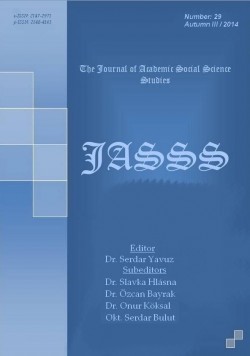HEALTH-SAFETY RISKS AND PRECAUTIONS in LIBRARY AND ARCHIVES BUILDING
KUZUCUOGLU, Hamdi and Alpaslan Ceylan, Hüseyin Health-Safety Risks and Precautions At Library And Archive Buildings. The Journal of Academic Social Science Studies, 2014, n. 29, pp. 313-338. Doi Number: http://dx.doi.org/10.9761/JASSS2552
Click to download the full text of this work
Abstract
Library and archive buildings are crucial both because they are public facilities used by protect many collections regarded as cultural heritage. As in all business locations, library and archive buildings have threats related to occupational health and safety and risks resulted from these. The most important difference diversifying library and archive buildings from other business locations is that the risks at these buildings not only pose a challenge for the staff, visitor, researcher and students using these, but also for library and archive material in form of cultural heritage holding light on the past such as rare collections, documents, maps and photos. Yet the loss of both human and cultural heritage collections cannot be restored. While these are structural risks that can give rise to accidents or be resulted with injury, impairment of health or death in case of emergency/disaster situations for the people using these buildings; all of the collections and archive materials in the feature of cultural heritage are affected by both these structural risks and environmental conditions such as temperature, humidity, light and dust. Because of these proactive precautions against the threats at whole of the building (reading hall, storage areas) or around it shall be made. In order to take these measures, it is important to have risk analyses in which potential threats in library and archive buildings are determined, monitoring based on calculation and observation, frequent revision activities and regulative and preventive control precautions. In this study, health and safety risks in library and archive buildings within the scope of Code on Occupational Health and Safety with the number of 6331 are evaluated and precautions in order to reduce current risks in acceptable levels are determined. With this aim, “5×5 Risk Assessment Table” method is used. In order to provide that the application shall be operable for all of the library and archive buildings and serve as a model, potential risks not at definite library or archive buildings but at any library and archive buildings are evaluated. In risk assessment study, risks that shall give harm to both staff and collections are analyzed. 40 risk factors are determined diversely for the staff and the collections, being 10 “Environmental Risk” and 10 “Disaster Risk”. Undoubtedly, it is possible to mention about hundreds of risk factors at library or archive buildings. However, in this study it is focused on threats that are mostly met.
Summary
Library and archives buildings, public facilities to be used by many people and is important for maintaining many works both cultural heritage listed. As in all businesses in building libraries and archives in terms of occupational health and safety hazards and incorporates the risks from these hazards. Most important difference between the library and the archives building with other businesses, staff uses only the building of risk, visitor, not only pose a threat to researchers and students; rare book also sheds light on the past, belgian, document, map and for cultural heritage attributes in the library and archival materials such as photographs is creating a threat. Because people can not be restored and the loss of both works are the property of cultural heritage. For people who use these buildings, In case of accident, disaster / emergency injury, impairment of health or structural risks that may result in death when available; artifacts and archival materials in the nature of the cultural heritage of all mankind, both of these structural risks as well as the temperature, not, light, are affected by risks arising from environmental conditions such as dust. Therefore, the whole building (read out, storage area) to take proactive measures against hazards that arise within or around the building is required. These measures can be taken to the library and risk analysis to identify potential hazards in the places of archive, monitoring based measurement and monitoring, continually reviewing activities and it is important to define the corrective and preventative control measures. In this study, 6331 No. covered by the Occupational Health and Safety legislation in the Act; library and archives buildings assessed health and safety risks in, measures to be taken are determined to be reduced to an acceptable level of existing risks. For this purpose, “5×5 Risk Assessment Table” method is used. Be available to all libraries and archives building of the application and the risks that may be encountered at any library or archives building rather than a specific library or archive building to be able to serve as an example has been evaluated. Risk assessment in the study were assessed for risks to employees and damage to both works. Separately for individual employees and works, 10'Ar ea “Environmental Risk” and 10 pieces “Disaster Risk” totaling 40 risk factors has been identified. Surely it is possible to mention the hundreds of risk factors in building a library or archive. However, most studies have focused on the dangers encountered in.
Keywords: Protection of Cultural Heritage, Occupational Health and Safety, Emergency Planning, Information and Document Management
